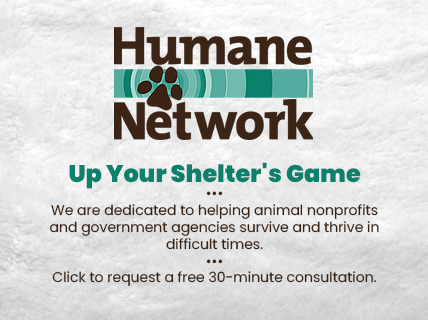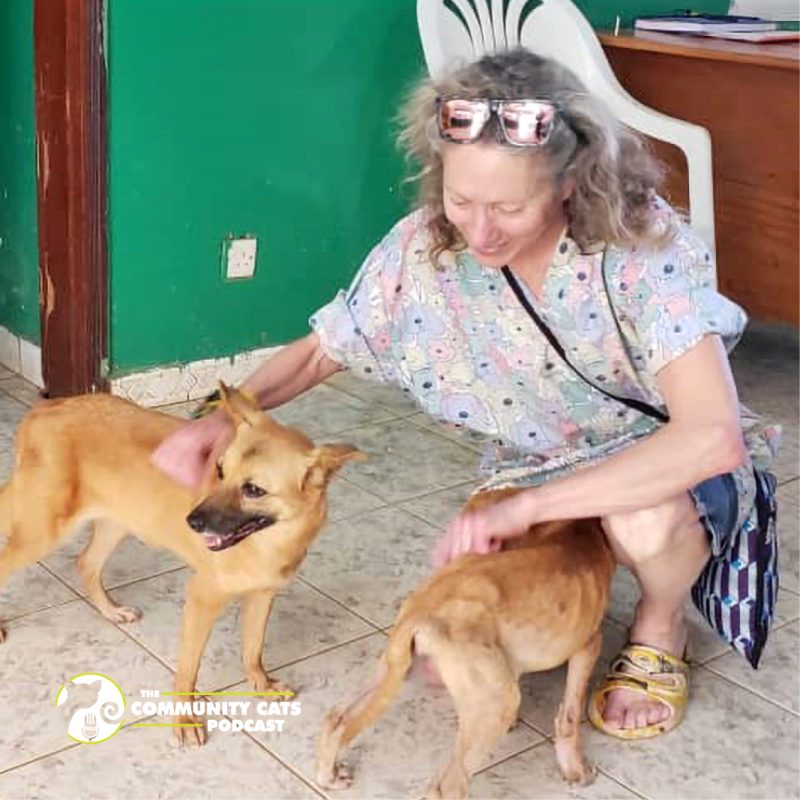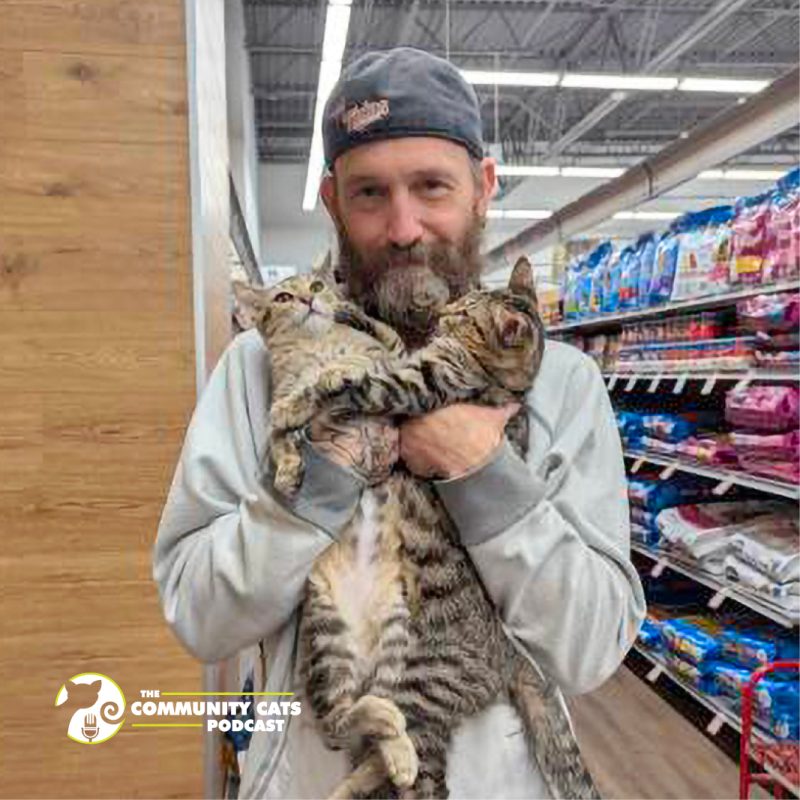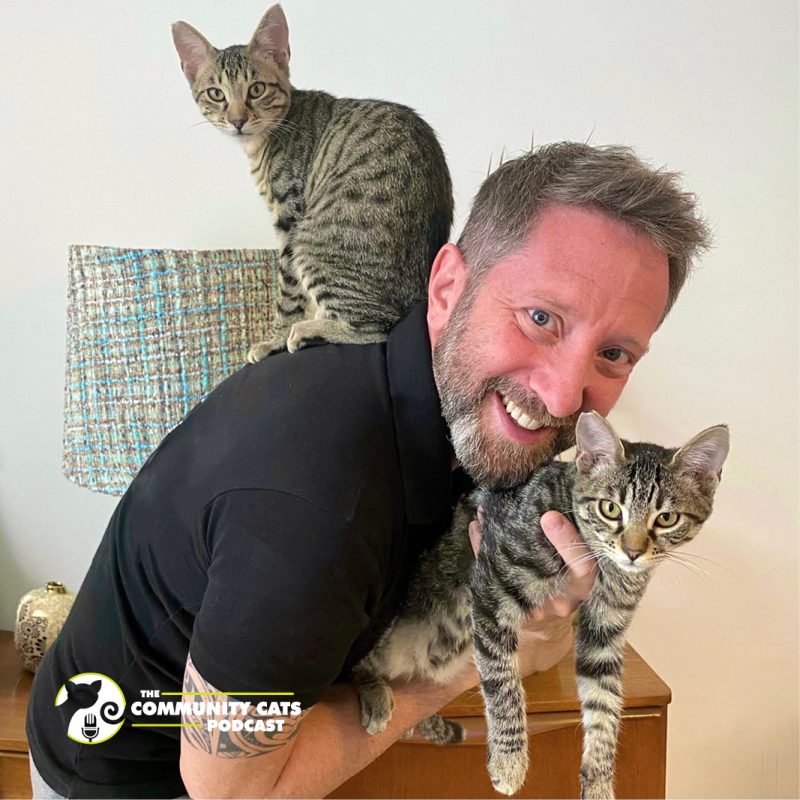
10 Myths & Facts About Spaying & Neutering Your Cat
February 10, 2022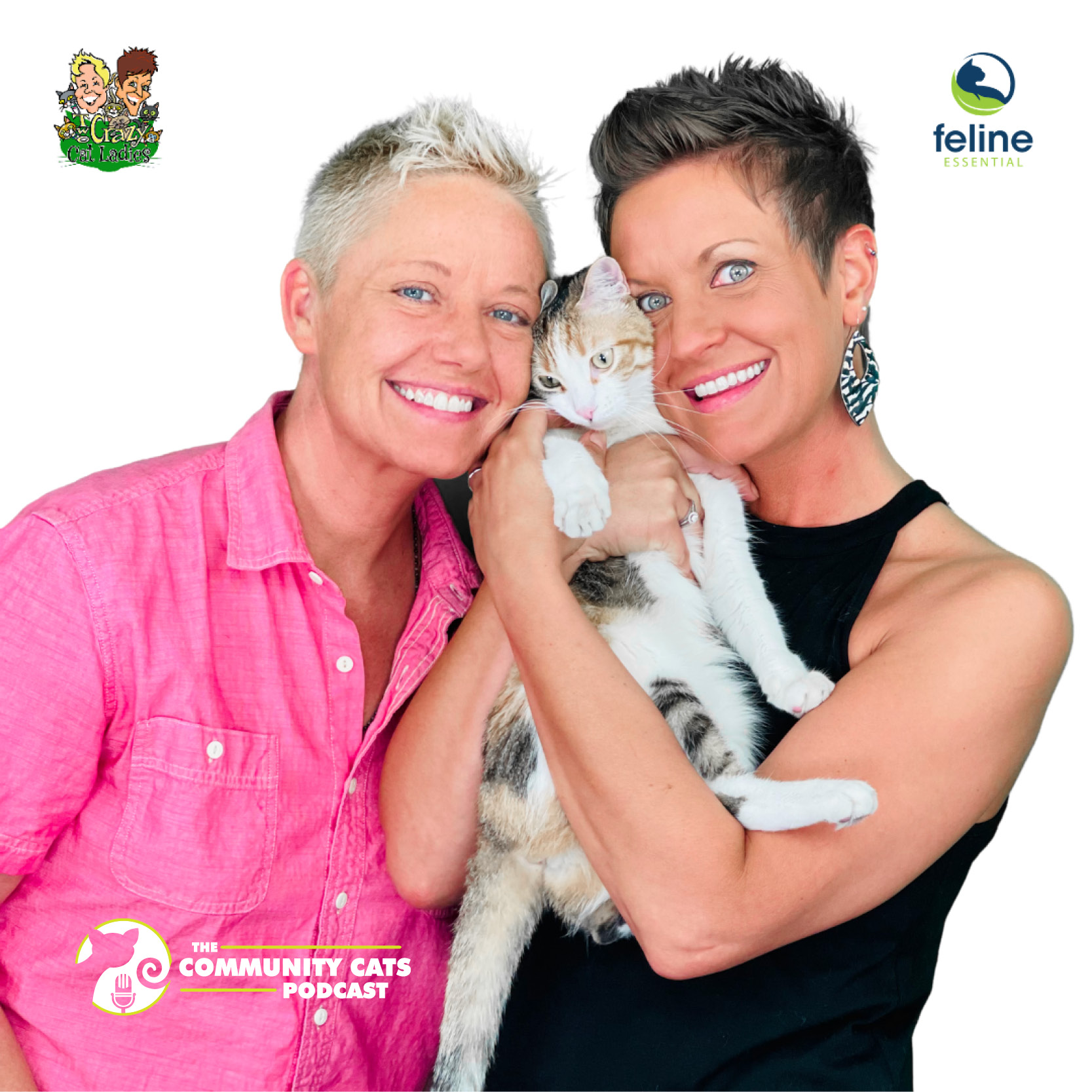
Building a Community with Two Crazy Cat Ladies, Jae Kennedy & Adrienne Lefebvre
February 22, 2022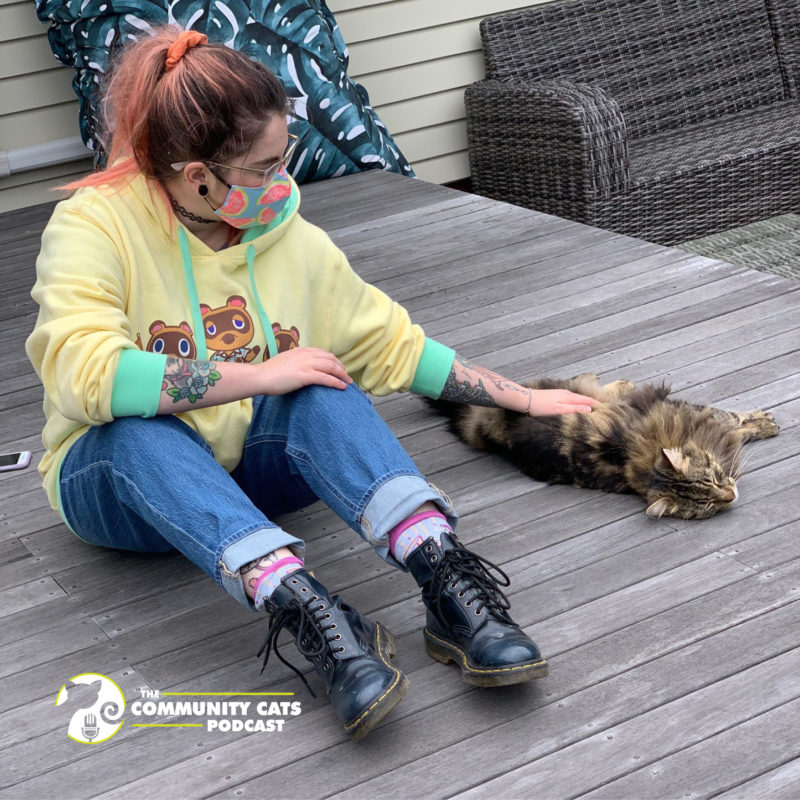
“I wanted to focus on keeping not just cats happy but owners happy with their cats and reducing owner surrender and things like euthanasia due to problem behaviors.”
Listen to Episode #443 Now
This episode is sponsored in part by Humane Network, Doobert.com and Maddie’s Fund.
Meet Molly Kelsey, a former vet nurse who worked with in-patient care and clinic administration, and now runs The Cat Counsellor as a feline behavior consultant, offering 1-on-1 support for cats and their owners. She’s based in New Zealand where it’s tough being a community cat. TNR practices are more restrictive and led by only grassroots volunteer-run organizations. In addition, there is public scrutiny regarding TNR due to ongoing concerns for local wildlife.
In this episode, Molly tells us more about the community cat situation in New Zealand and shares more about how she started The Cat Counsellor as a way to advocate for and empower people to become more effective cat companions.
She also shares important tips on how to understand and find solutions for common problem behaviors that might be happening at home. Molly tells us more about house soiling, litter box issues, and aggression to other pets and people in the home. Here’s one tip that Molly shared with us: “If you’re playing with a laser toy, finish the laser beam on a tangible item. A physical toy they can touch or a treat, and this prevents frustration from not getting anything from the chase.”
Notes:
- To learn more about Molly Kelsey and The Cat Counsellor, visit her website here.
- Follow her on Facebook and Instagram to keep up with her feline behavior tips and 1-on-1 sessions.
- To book a session with Molly, visit her booking link here!
If you enjoyed this episode, you may also enjoy Stacy’s interview with Suzy Langer (President Bifford) | Episode 423.
Read Episode #443 Now
Kristen Petrie [00:00:03] You've tuned in to the Community Cats Podcast. Ready? Let's go.
Stacy LeBaron [00:00:13]
Welcome to the Community Cats Podcast. I am your host, Stacy LeBaron. I have been involved in helping homeless cats for over 20 years with the Merrimack River Feline Rescue Society. The goal of this podcast is to expose you to amazing people who are improving the lives of cats. I hope these interviews will help you learn how you can turn your passion for cats into action. Today we're speaking with Molly Kelsey. Molly lives in Auckland, New Zealand, with her partner, Two Rats, and her dog, the Honorary Cat, while they were renting. Molly has worked with cats for over ten years as a vet nurse, in clinic administration, and now as a behavior consultant. Molly made the decision to go back to University and study behavior after meeting one too many cats whose daily needs were not being met and who exhibited problem behaviors as a result. Studying behavior postgrad has given her the tools to work with owners to understand their cats in order to help them achieve a higher level of mental and physical wellbeing, all the while resolving problem behaviors. The Cat Counselor was launched earlier this year and she is learning something new with each case that she takes on. She is proud to offer her services to rescue groups and organizations in her area. In her spare time, you'll find her baking, reading, spending time with her family, studying, and crafting. Molly, welcome to the show.
Molly Kelsey [00:01:35]
Thank you for having me.
Stacy LeBaron [00:01:37]
So first and foremost, I know you're a cat lover, but how did you become so passionate about cats?
Molly Kelsey [00:01:43]
Ever since I was a little kid, I've always had a cat, and they've just been such a valuable companion to me over the years. And there's just something so intrinsically relatable about them that I just find it's really just wholesome and just makes you feel fantastic. And I just love how they make everyone's lives they meet so much better.
Stacy LeBaron [00:02:07]
Yeah. Now you were a vet nurse before you turned into a feline behaviorist. Tell me about your experiences that you had when you were a vet nurse.
Molly Kelsey [00:02:17]
So as a vet nurse, I dealt primarily with inpatient care, so we had cats that were coming in that would be injured or unwell, the occasional stray or slightly stray cat that hadn't been handled for a while. So it gave me a good, well-rounded exposure to all the different types of cats and the different situations we find them in was really rewarding to see them go from being unwell to ready to go home. And I learned a lot from these cats that were in often quite compromised states.
Stacy LeBaron [00:02:48]
Before we jump into all your behavior information, tell me a little bit about what's it like being a community cat in New Zealand. What's sort of the situation for community cats?
Molly Kelsey [00:02:59]
It's quite rough if they're lucky enough to have an organization overseeing their colony or their area and they're getting food, water, and if possible, parasite control, it's okay. But a lot of cats are kind of at the mercy of the elements. And also if there's any neighbors that don't want them around them, it's quite a compromising situation for them. It's got a lot of improvement to be done.
Stacy LeBaron [00:03:24]
We talked a little bit about their pretty restrictive about trap, neuter, return and where you can do it, and a lot of concerns about wildlife and predation. And it's a very structured environment here in the United States. It's a lot of well, if nobody is saying anything, we'll just do trap, neuter, return, and then hopefully the complaints will go away and the colony will get smaller and all that kind of stuff. But it seems like in New Zealand it's a little bit more official, I guess I would say, or looked over by the government. The government is involved in a lot of the policy.
Molly Kelsey [00:03:59]
Yes. So here in New Zealand, we have the FCCA, which is our main or only governing body that relates to animal welfare. And they don't openly advocate for trap, neuter return. So it's often left to grassroots organizations such as Nine Lives Orphanage and Gutter Kitties. There are Auckland ones, and they're all volunteer-based. And there's been a lot of public scrutiny about the whole concept because of the predation on our native wildlife.
Stacy LeBaron [00:04:32]
Ultimately, at the end of the day and I've been involved with a colony of cats. I started out with an organization that had a group of 300 cats and back in 1994, and the last cat passed away in 2008, and we had 14 feeding stations. And now we have zero. And so TNR can be successful if it's managed properly. So if there are folks that are interested, we do have a monthly training session, a trapper certification workshop here at the Community Cats Podcast. And so folks, if they want to learn how to do TNR correctly and with the highest impact, it's a great program. I would hope folks would tune into it and we do it with Neighborhood Cats. So that's great. One other question I have for you, because this is sort of a passion of mine. Whenever I go to a new place, I want to find out, is there a cat cafe in New Zealand?
Molly Kelsey [00:05:25]
Yes. So in Auckland, we have Purrs and Beans who run sort of like a nonprofit. They have all rescue cats. They foster cats, and they have a focus on special needs cats, which is another small passion of mine. I love them. So those guys are in Auckland, and there's a couple of cafes scattered throughout South Island.
Stacy LeBaron [00:05:46]
Excellent. So when you say special needs kitties, what type? Are feline leukemia-positive kitties or kitties that are missing a leg or all of the above?
Molly Kelsey [00:05:56]
All of the above. I have a special passion for cats with Wobbly Cat Syndrome. I fostered a couple of those, and they are amazing. Their resilience and zest for life is really inspiring. Same with cats. I follow a few with dwarfism. Yeah, just the resilience with cats is amazing. I love it.
Stacy LeBaron [00:06:17]
So at our Online Diversity Day, we had Suzi Langer there and she's PresidentBifford.com is the website. President Bifford or Bifford, her cat is a CH kitty, and they do a lot of advocacy around that because she is a technician, too. And she has found at a lot of vet practices, you'll pull out a CH cat and they'll think that the cat is having a seizure or something if they are not fully aware or notified of what the cat’s situation is like and they treat the cat inappropriately because they just aren't aware. So she's designed some tags that go on the carriers that identify this cat as a CH kitty and how to handle it and all that kind of stuff. So she's doing some grassroots outreach. It's really a cool program and so she was part of our diversity day, and I think I had her on the podcast, too. So let's talk about you and the cat counselor. When you started The Cat Counselor, what were your goals?
Molly Kelsey [00:07:16]
Mainly advocating and empowering people to become more effective cat companions. And I wanted to focus on keeping not just cats happy, but owners happy with their cats and reducing owner surrender and things like euthanasia due to problem behaviors.
Stacy LeBaron [00:07:34]
In your experience, I've never worked in a vet clinic. So what do you define as the problem behaviors that would force somebody to euthanize a cat?
Molly Kelsey [00:07:43]
First, two that come to mind are house soiling, which is one of the biggest problem behaviors that we see, and then also aggression to other animals in the house and aggression to people.
Stacy LeBaron [00:07:55]
So if you're working with a client on either of those two issues, what's the low-hanging fruit that folks can do to help? If they've got a cat that's peeing around the house or not using the litter box, what are your top two or three tips?
Molly Kelsey [00:08:10]
First, would be a vet check to rule out any medical issues that could be causing it. Second is providing a suitable toileting setup for your cat. A small littler box with a subpar substrate in the laundry where the washing machine and everything's going is not a great spot for them to do their business. And third, would be to make sure you clean it enough. Once a week, cleaning and removing stuff is not enough. We need daily cleanups.
Stacy LeBaron [00:08:41]
So if the litter box is not down in the laundry room, do you recommend a litter box on every floor? Do you recommend a covered litter box or not a covered litter box? And how do we figure out what size we need?
Molly Kelsey [00:08:55]
So with cats, they're like us. They all have their preferences. Some cats do like the hooded ones, but I always tell people to remove the flap because they can trap the odor. And that can be quite off-putting in the first place. Size-wise, I tell people to go as big as you can fit. Some cats like to push the substrate around and bury their poo and things like that, so that's just part of their natural behavior, and they actually get some satisfaction out of going through the motions of doing that. And also with hooded ones, you just have to be careful that they don't feel too trapped. Some of the smaller ones I've seen are just recipe for disaster.
Stacy LeBaron [00:09:31]
Right.
Stacy LeBaron [00:09:37]
And do you think you should have a litter box on every floor if you have a multi-level house? Or is it okay to keep them in a bathroom or I guess where is the best place?
Molly Kelsey [00:09:50]
So with litter boxes, I don't really go by levels of the house. I go by number of cats in the house. So one cat I usually tell people if it's indoor 24/7 to have two, and if they've got outside access, I say one multi-cat household, I say number of cats plus one, always. So there's no guarding of a litter box or fighting over one particular litter box. Location-wise, bathroom is good if it's big enough and you haven't got lots of through traffic all the time. I know some people put them in the garage, which can work as well if you're just using the garage for storage and you haven't got a car coming in and out. It just depends on how much space you have.
Stacy LeBaron [00:10:33]
Do you have a preference on the type of litter that people use? Cats use.
Molly Kelsey [00:10:40]
Yeah. So there has actually been some studies done about litter substrate preferences, and it's found that a sandy texture that clumps together is the most preferred. Some cats don't like the palette-style litter that can get in between their paw pads. It can be quite uncomfortable. The closest thing I can relate it to is like loose gravel under your feet. It doesn't feel very nice. So something sandy, loamy and mimics where they would normally bury their waste outside is your best bet.
Stacy LeBaron [00:11:12]
Aggression. Spend a little bit of time talking about aggression. I've had several cats in my life that have not gotten along 100%, and I've had to do a lot of heavy negotiating with them to figure out a way for them to get along. What are your tips and tricks with regards to cat aggression?
Molly Kelsey [00:11:32]
So with cat aggression, there are a few types. You have things like misdirected aggression, where there will be frustration about a particular situation or cat or person, but then someone else will be nearby and the aggression gets directed to them. And then there's the actual aggression where it's focused on a particular person or pet. So my first thing I always tell people is safety first. If you're worried about keeping animals together, if they're fighting or cats going after the dog. Separate them. It's not worth the stress and the danger. And I also tell people one of the main things is to stop using your hands as a toy. That is probably my first thing when I have people that got cats that nip or bite, is stop using your hands as a toy.
Stacy LeBaron [00:12:21]
We interrupt this podcast for a quick trivia question. Where is the single place with answers to all of your animal welfare questions? Yes, even the one that kept you awake until two in the morning. Anyone, anyone? Bueller? It’s Maddie’s Pet Forum. Maddie's Pet Forum is the only dedicated forum for our industry where you can find answers from colleagues fast and free. Stop doom scrolling and join today. Visit
Forum.Maddiesfund.org/cats.
Stacy LeBaron [00:12:50]
Could your animal welfare organization use a tune-up? Humane Network can help. You can get a free 30-minute consultation to talk through your challenges and get ideas on how your organization can be more successful with less stress. From board development and fundraising to strategic planning and operations, Humane Network has got you covered. Whether you are a large or small, non-profit or government, it's a live and thriving program led by a certified animal behavior consultant, features specially designed training for shelter and clinic staff on enrichment, stress reduction, safe animal handling, and behavior modification. With Humane Network, you receive individualized advice and support customized to meet your organization's unique needs, and Humane Network can lighten your load by taking on fundraising, communications, and other tasks you struggle with. Contact Humane Network today for a free 30 minute consultation. Visit Humanenenenetwork.org that's Humanenetwork.org.
Stacy LeBaron [00:13:34]
Team Doobert is at it again and now they have an amazing companion case management module that once again revolutionizes how you rescue animals. Doobert partnered with Dallas Pets Alive and the Spay Neuter Network to build a powerful solution that allows you to manage cases of any kind, whether owner surrender calls or emails, community cat tracking, and reporting. Doobert is the only system that integrates two-way text messaging, automatic follow-ups, and even a rehoming solution that every organization can use. No more trying to manage ten different technologies when everything is all in one place and tightly integrated. From fostering to transport, fundraising to e-commerce, supply and demand to case management, Doobert has everything you need to streamline your operations so you can focus on saving more animals. Check out the new companion case management module at https://www.doobert.com/ccm and get signed up today.
Stacy LeBaron [00:14:39]
Another thing I did, I know that when my kids were like toddlers and my cats would lose patience. I did do like at 7:00 at night, I separated everybody because then I knew I could just sort of try and keep the peace and I didn't have to worry about like my cat swatting at my kid or my kid swatting at the cat and all that kind of stuff. So I thought having a separate timeout space was pretty good. You've recently, I think recently, put together a beautiful website and also you have a great presence on social media so you actually do consults with folks one on one, right?
Molly Kelsey [00:15:21]
Yes. I do them online by a Zoom and then when locked down here, finishes, I'll be back doing it in person in Auckland.
Stacy LeBaron [00:15:30]
How is it different doing a consult via Zoom versus in person? I would assume you probably prefer the in-person to the Zoom, but yet do you still feel like you're effective doing a Zoom consult?
Molly Kelsey [00:15:43]
Definitely. Now, with technology, owners can send me videos of the behaviors. I get video tours of the house. They show me where everything is located. I have forms that people go through and they can ask for things that normally would take up quite a bit of time during in-person consults. So it does have a lot of pros and it's definitely more affordable and accessible for people versus in person.
Stacy LeBaron [00:16:08]
Speaking of, we've talked a little bit before we hit the recording button about sort of the indoor-outdoor, indoor-outdoor cat, indoor-only cat, sort of this type of conversation. And I know you mentioned that you prefer having cats indoor only. Do folks have catios in New Zealand? And then what sort of tips do you provide for enrichment? Because if you're committing to have a cat being indoor only, you're making a commitment above and beyond putting the food out, scooping the litter box. There's a lot more to being a companion of that cat to ensure that they stay healthy. So what are the key components to enrichment? And do you find people using catios as one way, but that's sort of a passive way. So maybe there's also active engagement in there too.
Molly Kelsey [00:16:55]
Yes. So in New Zealand, catios are slowly gaining popularity. We do have an issue where a lot of people rent in New Zealand versus actually owning their own home. So things like catios and catproof fencing are not often a feasible option. So people usually go to just being contained fully in the house or even having a dog kennel run made of mesh that they take the cat outside to have some outdoor enrichment. So with cats that are stuck inside full time, I always advise people to meet all their needs that they would be going outside to do. So we've got digging, we've got scratching, climbing, perching on things up high, and looking down and surveying the kingdom. We've got chasing after prey and playing with prey, things like watching the birds outside and having treat puzzles, just basically meeting all those essential daily needs they have. Because otherwise, you're just going to end up with a cat that's frustrated and possibly even depressed.
Stacy LeBaron [00:17:59]
What are your best recommendations with regards to, like toys or playtime? Actually, one other thing, I get a big complaint, and I have lived with this too, which is the cat that won't let me sleep through the night. And so are there any thoughts and ideas around? Like, I mean, I've tried the exercise until they're exhausted at night, feed them later in the day or feed them the wet food later in the day. But I don't know. And sometimes those work, sometimes they don't. Do you have any thoughts for a magical night's sleep? Because I love my sleep for sure.
Molly Kelsey [00:18:38]
Yeah, fair enough. Sleep is precious. So you've done all the things that usually people try first, and it basically just comes down to cats are individuals. But they are all naturally most active between dusk and dawn. So I tell people to give them as many things to do during that time. So before you go to bed, make up a few food puzzles and actually hide them around the house. And first off, you can start pointing out them to your cat when you go to bed. So they kind of get a bit of help initially, but slowly you make it more and more work for them to find the puzzle and actually get the food out. And I find that satisfies that prey-predator brain for a few hours and then just giving them lots of things to do, lots of things to hide in while you're sleeping. So they're less likely to come and seek you out for some entertainment.
Stacy LeBaron [00:19:31]
Talk about food puzzles. What are they? I think a lot of people don't even still know what a food puzzle is.
Molly Kelsey [00:19:37]
Yes. So food puzzles are fantastic. They exercise the body, the brain. Cats get that satisfying hit of dopamine when they successfully get the food out versus a conventional bowl. It keeps them occupied for longer. And it also slows down eating. So you're less likely to get cats regurgitating their food from wolfing it down. And it's just another way that owners can bond with their cats by figuring out the puzzle together or showing them a new puzzle. There's even puzzles you can make yourself at home, like DIY ones. So it's great to get all the family involved, which is really nice.
Stacy LeBaron [00:20:17]
That's great. So if folks are interested in finding out more about your program, how would they do that?
Molly Kelsey [00:20:26]
Yep. So they can head to my website, which is thecatcounselor.com. Otherwise, you can find me on Instagram at the Cat Counselor or Facebook at the Cat Counselor It's spelled with an S. So the different spelling for my overseas folks. And yeah, you'll find me most active on Instagram and on my website as well.
Stacy LeBaron [00:20:47]
Great. We'll make sure those links get into the show notes for sure, too. Molly, is there anything else you'd like to share with our listeners today?
Molly Kelsey [00:20:54]
Yes, if you're playing with a laser toy, finish the laser beam on a tangible item. So a physical toy they can touch or a treat. And this prevents frustration from not getting anything from the chase.
Stacy LeBaron [00:21:07]
Yeah, I've heard that, too. Which is you want to always make sure at the end of the play session that whatever you had as your prey or having something that they've caught it.
Molly Kelsey [00:21:17]
Yup. Very important,
Stacy LeBaron [00:21:03]
Molly. Well, thank you so much for being a guest on my show today and I hope we'll have you on again in the future.
Molly Kelsey [00:21:24]
Thank you for having me.
Stacy LeBaron [00:21:26]
That's it for this week. Please head over to Apple podcast and leave a review. We love to hear what you think and a five-star review really helps others find the show. You can also join the conversation with listeners, cat caretakers, and me on Facebook and Instagram. And don't forget to hit, follow or subscribe on Spotify, Apple Podcasts, Google Podcasts, YouTube, Stitcher, or wherever you listen to podcasts, so you don't miss a single show. Thanks for listening and thank you for everything that you do to help create a safe and healthy world for cats.
Kristen Petrie [00:22:00]
Did you attend the Online Cat Conference in January? If you did, we hope you enjoyed the incredible content provided by our expert presenters and hope their information and encouragement will help you turn your passion for cats into action. Events like the Online Cat Conference would not be possible without the support of our generous sponsors. Our Premier Sponsor was Maddie’s Fund. Leadership Sponsors include Best Friends, TICA, Dr. Elsey’s Cat Products, and Care. Sustaining Sponsors included Vest Pets Atenial, Humane Network, the MSPCA, and the Vermont Humane Federation. If your business or organization would like to support content that makes a difference for cats in communities worldwide visit CommunityCatsPodcast.com/eventsponsorship

